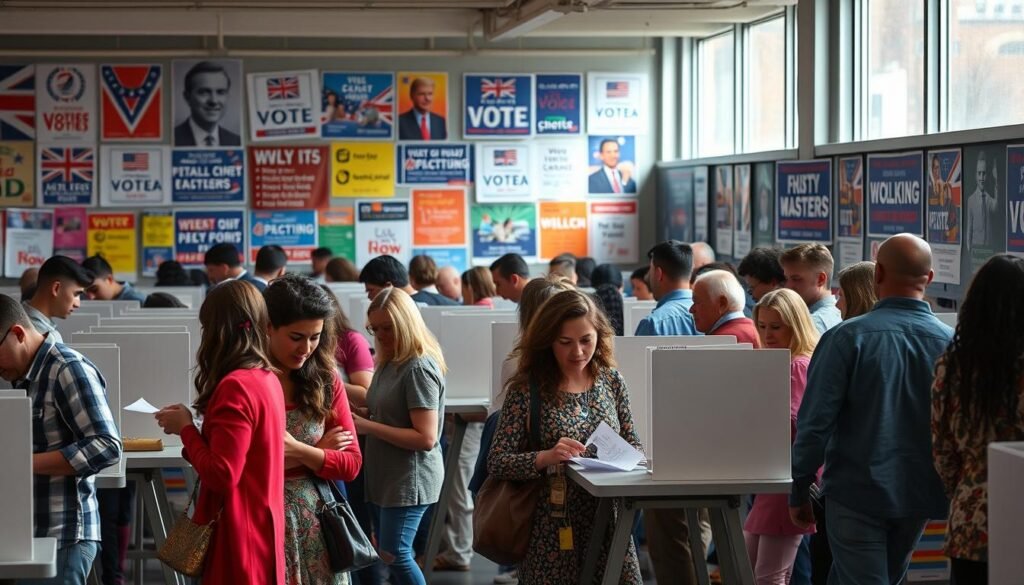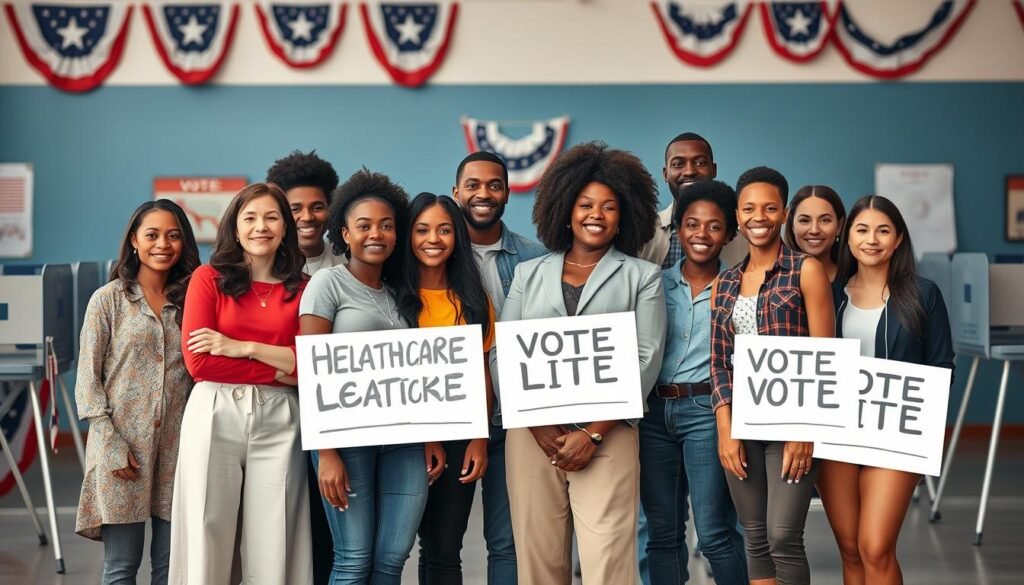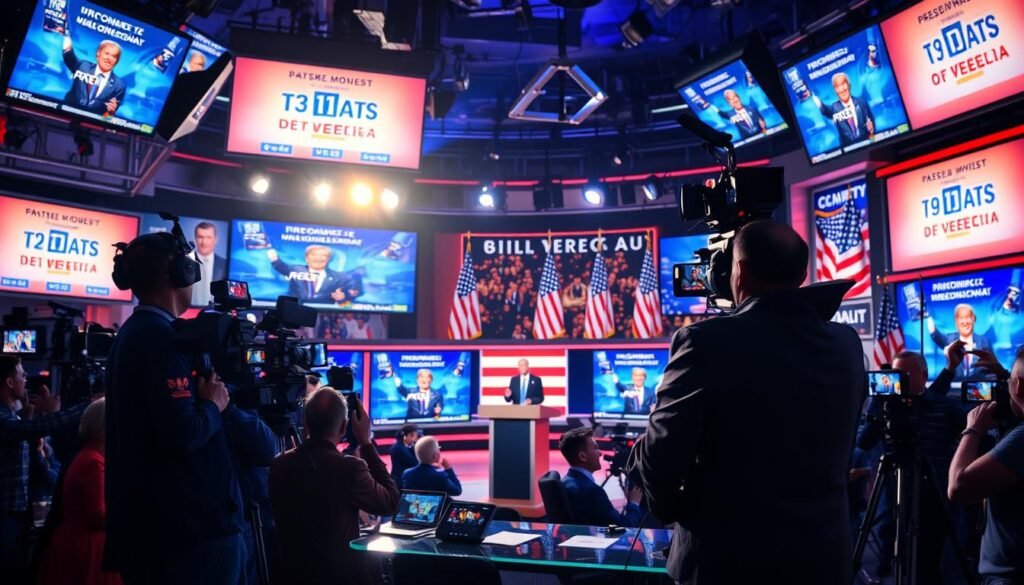The US presidential elections are key to democracy in the USA. They let citizens pick their leaders every four years. This process shows what the people want and guides the country’s future at home and abroad.
The 2024 election is shaping up to be big, with Joe Biden and Donald Trump leading the charge. They bring different ideas and visions for the USA. The outcome will affect many areas of life and government.

It’s important to know about the history and importance of the presidential elections. The big parties, Democrats and Republicans, and smaller ones too, offer many choices. The decisions made in these elections impact lives and communities far and wide.
Key Takeaways
- The US presidential elections are pivotal for democracy in America.
- The upcoming 2024 election features major candidates Joe Biden and Donald Trump.
- These elections shape domestic and international policy directions.
- The Democratic and Republican parties hold significant influence within the electoral system.
- The electoral process reflects the voters’ collective opinion and choices.
The Importance of US Presidential Elections
The US presidential elections are crucial for Americans and the world. They let people share their views through voting. This process helps shape important government decisions that affect our lives.
These elections matter a lot outside the US too. What happens in Washington can change how the US works with Europe. For example, a new president could make big changes in how the US deals with NATO and the European Union. This could make or break partnerships across the Atlantic.
The results also affect security and economic ties. The US’s role in NATO keeps Europe stable, especially for countries that count on American support. A strong leader can make sure countries work together well to tackle global issues.
| Candidate | Impact on Transatlantic Relations | Focus Areas |
|---|---|---|
| Joe Biden | Increased cooperation with European partners | NATO support, global challenges, security commitments |
| Donald Trump | Potential decline in democratic norms, America First policies | Tariffs, economic pressure, reduced NATO engagement |
| Kamala Harris | Reinforcement of European stability through NATO support | International institutions, climate change cooperation |
How well democracy works depends on how many people vote. Getting citizens involved makes democracy strong. Elections are key to making sure the government acts in the people’s best interests.
Historical Context of US Presidential Elections
The history of presidential elections in the United States is filled with political milestones and changing values. The first election was in 1788, starting a journey of democratic participation. Over time, the way presidents are elected has changed, especially with the Electoral College.
Important moments in electoral history stand out. For instance, Abraham Lincoln won big in 1864, getting 212 electoral votes and 55.0% of the popular vote. This election showed how leaders can make a big impact during tough times.
In 1920, Warren G. Harding won with 404 electoral votes and 60.3% of the popular vote. This showed how American voters’ priorities change over time.
Other key elections include those in 1948 and 1976. Harry S. Truman won a close race in 1948, while Jimmy Carter got 50.0% of the vote in 1976. These elections show how voting trends change.
The 1980 election, with Ronald Reagan winning 489 electoral votes, showed how economic issues affect voters.
Some elections have seen the winner not get the most popular votes. This happened in 1876, 1888, 2000, and 2016. These events lead to talks about fairness in the electoral system. Every four years, America goes through its electoral history, learning and moving forward.
Political Parties’ Evolution in America
The early 1800s were a big change for political parties in the USA. The Democratic-Republicans took the lead in the Senate after the 1800 elections. Meanwhile, the Federalists had only a few seats left. This was the start of more clear political groups.
By the 1850s, a new party, the Republican Party, appeared. It was made to stop slavery from spreading into new territories. This made the political scene more competitive, with the Democratic and Republican Parties fighting for power.
In the 19th century, the Senate became a key place for party unity. It was often split between Democrats and Republicans. To help with this, steering committees were set up in the 1890s. These committees helped make parties stronger.
In the early 1900s, the Republican Party changed again. They chose Charles Curtis as their leader in 1925, focusing on his leadership skills. This change showed a new way of picking party leaders.
The Democratic Party is seen as the left-leaning option, especially since the New Deal. The Republican Party is seen as right-leaning. Even with third parties like the Constitution, Green, Alliance, and Libertarian, the Democratic and Republican parties have won most presidential elections since 1852.
Now, about 35-45% of voters call themselves independents. Yet, many of these independents often vote for one of the big parties. This shows the strong role of the Democratic and Republican Parties in American elections.
The Electoral Process Explained
The US electoral process is a complex system. It picks the President and Vice President through the Electoral College. This starts with primary elections where parties choose their candidates. Then, the general election happens on the first Tuesday after the first Monday in November. It’s a key moment for voters.
There are 538 electors in the Electoral College. They include 435 representatives from the House, 100 senators, and 3 from Washington D.C. A candidate needs at least 270 electoral votes to win. Most states give all their electoral votes to the top candidate, like California with 55.
But, Maine and Nebraska don’t follow this rule. They give electoral votes based on how people voted in each area. In 29 states and D.C., electors must vote as their state did. Yet, in 21 states, electors can vote however they want.
It’s vital to know how elections work. This system shows how crucial every vote is. Swing states can really change the election’s outcome.
| Electoral College Overview | Details |
|---|---|
| Total Electors | 538 |
| Votes Required to Win | 270 |
| States with Winner-Take-All | Most states excluding Maine and Nebraska |
| Electors from Washington D.C. | 3 electors |
| Pledged Delegates | Support assigned candidates in primaries |
| Unpledged Delegates | Known as superdelegates, can choose freely |
| Electoral Votes Count Date | January 6 following the election |
Voter Demographics and Trends
Understanding who votes is key to understanding election trends in the U.S. Recent elections have shown big changes in voting patterns among different groups. These changes are making a big impact on who wins elections.
Shifts in Voting Patterns
The way people vote has changed a lot in recent years. Now, 44% of Democratic voters are Hispanic, Black, Asian, or multiracial, up from 23% in 1996. This shows the Democratic Party is getting more diverse.
On the other hand, 79% of Republican voters are non-Hispanic White, down from 93% before. These changes mean political campaigns need to change to appeal to more voters.
Impact of Age and Race on Voting Behavior
Age and race greatly affect how people vote. For example, 77% of Black voters support Kamala Harris for president in 2024. Young people also tend to vote Democratic, so candidates need to reach out to them.
Trump gets a lot of support from White and older voters. The 2020 election saw a 66% turnout, the highest since 1900. This shows more diverse groups are getting involved in voting.
Minority groups are voting more, with Black eligible voters expected to hit 34.4 million by 2024. Asian Americans are also growing fast in number. These trends will likely change future elections.
Key Issues Influencing Voter Choices
As the 2024 presidential elections near, many voter issues are becoming key in shaping opinions and election results. Issues like the economy, healthcare, and social justice are crucial in guiding voter decisions. By understanding these issues, candidates can tailor their platforms to match public views, affecting their success.
Economy and Healthcare
Economic conditions and healthcare are top voter concerns, showing what Americans value most. Voters worry about inflation, taxes, and how to grow the economy. They also care about healthcare costs and access to services.
Candidates’ views on these topics can greatly influence voters in key states. This shows how important these issues are in the election.

Social Justice and Rights
Social justice issues are also key for voters, especially for younger people. Issues like civil rights, reproductive rights, and LGBTQ+ rights rally certain voters. Candidates who stand strong on these issues can gain support or face criticism.
Recent polls show these social and political beliefs greatly affect how people vote. This shows the big role of social concerns in elections.
| Voter Issue | Key Concerns | Influence on Voting Behavior |
|---|---|---|
| Economy | Inflation, taxation, job creation | Critical for undecided voters; sways demographic turnout |
| Healthcare | Access, affordability, insurance policies | Highly prioritized among low-income and senior voters |
| Social Justice | Civil rights, reproductive rights, LGBTQ+ rights | Mobilizes younger voters, important for progressive platforms |
How elections are influenced by these factors will keep changing. It’s vital for candidates to understand what voters care about. This knowledge is key to winning in future elections.
US Presidential Elections: The Role of Third-Party Candidates
Third-party candidates are key in US presidential elections. They highlight important issues that the big parties might ignore. The main parties are usually the Republicans and Democrats. But, third-party candidates have a big impact by pushing for issues that upset voters.
Third-party groups, like the Green Party, focus on big issues like the environment. Candidates like Andrew Yang, who talked about a universal basic income in 2019, show how new ideas can enter the debate.
These candidates bring up topics like social justice, economic change, and healthcare. Some voters feel these issues aren’t covered well by the big parties. This leads the big parties to take on some of these ideas to draw in more voters.
But, third parties face big challenges. They often don’t have much support in local elections, which makes it hard to win big offices. The US public is also slow to accept big changes. Yet, third parties can push for important issues that eventually become part of the mainstream.
History shows the lasting effect of third-party efforts. The Anti-Masonic Party started the idea of nominating conventions in the 1830s. Ross Perot’s 1992 campaign showed how third-party candidates can really shape an election.
| Third-Party Candidate | Election Year | Key Issue | Popular Vote (%) |
|---|---|---|---|
| Ross Perot | 1992 | Economic Reform | 18.9 |
| Andrew Yang | 2019 (Democratic Primaries) | Universal Basic Income | N/A |
| Green Party | 2020 | Environmental Challenges | 2.7 |
Even with challenges, third-party candidates add depth to political talks. They push for issues that might later be taken up by the big parties. This shows their important role in democracy.
Presidential Election Campaigns and Media Influence
Presidential election campaigns have changed a lot because of media’s big impact. Traditional media used to tell voters about candidates and shape their views. Now, social media lets candidates talk directly to voters, making it easier for them to join in debates.
About 18.8% of U.S. adults now get political news from social media. This means platforms like Twitter are key for campaigns.
Voters in early states really care about voting and often go to political events on weekends. Media plays a big role in checking out candidates, especially for those not in early primary areas. People want a mix of news, from fun updates to deep policy talks.
The way we get news has changed, with more people sticking to news that matches their views. This has led to fewer discussions across different political sides.
The current election is the longest in U.S. history, and candidates face a lot of doubt from the public. Journalists have a tough job, especially when talking about candidates’ age and health. Experts like Dr. Becker say young voters are turning to social media for news, which is also true for students like Jaylynn Lawlah who wants to stay informed but is busy.https://progressivemind.in/scientists-have-discovered-a-large-liquid-water-on-mars/

Candidates use social media to spread their messages and sway voters. Sometimes, they even use funny tactics to poke at their opponents. The 2018 Texas Senate race showed how much money is spent on social media ads, with a whopping $93 million. As companies like Meta change their rules on political ads, the role of media in shaping elections keeps changing.
| Media Impact on Election Campaigns | Key Statistics |
|---|---|
| Primary source of political news | 18.8% of U.S. adults rely on social media |
| Social media’s impact on voting | Twitter reduced Republican vote share in 2016/2020 |
| Interest in political discussions | Decreased from 35% in 2016 to 26% in 2020 |
| Voter fatigue from political content | 55% felt worn out by political posts |
| Voter engagement at political events | Strong commitment observed among early state voters |
Conclusion
The US presidential elections show how America’s democracy works. They reflect the wide range of hopes and fears of the people. The elections are a key part of our democracy, showing how voting trends and big issues shape our choices.
Climate change is a big topic, but it’s not always the top concern for voters. Many people focus more on the economy, healthcare, and education. These issues deeply affect their decisions.
Looking at past elections, we see how complex issues connect. For instance, worries about climate change affect some voters a lot. They see it as linked to economic and security issues. This shows how important it is for voters to understand these connections.
This knowledge helps voters make better choices. It’s key to democracy, making sure everyone’s voice is heard. The electoral process has important steps, like counting votes on January 6, 2025. These steps keep the election fair and true to democracy.
For democracy to work well, we need an informed and active people. It’s vital for our democracy to reflect the many voices and values of our country.
FAQ
What is the significance of US presidential elections?
US presidential elections are key because they let citizens have a say in government. They help shape the country’s future by reflecting the people’s views and desires.
How often are presidential elections held in the USA?
Elections for the president in the USA happen every four years. They take place on the first Tuesday after the first Monday in November.
What role do political parties play in presidential elections?
Political parties, like the Democrats and Republicans, pick candidates and run campaigns. They show the views and feelings of the public, affecting the election.
How does the Electoral College work?
The Electoral College has electors who vote for the president. A candidate needs 270 electoral votes to win. In the general election, voters in each state pick these electors.
What trends have been observed in voter demographics in recent elections?
Recent elections have seen changes in who votes. Younger people often vote for Democrats, while older, White voters tend to vote for Republicans.
What key issues influence voter choices in presidential elections?
Important issues like the economy, healthcare, social justice, and taxes affect voters’ choices. Candidates’ views on these issues play a big part in making decisions.
How do third-party candidates impact US presidential elections?
Third-party candidates can change the game by drawing in voters unhappy with the main parties. They might not win, but they can still sway the election.
What role does media play in presidential election campaigns?
Media is key in shaping what people think by sharing news about candidates and issues. It helps spread campaign messages and fights against false information, affecting the election.
Source Links
- https://dk.usembassy.gov/usa-i-skolen/presidential-elections-and-the-american-political-system/
- https://kz.usembassy.gov/summary-of-the-u-s-presidential-election-process/
- https://www.pewresearch.org/politics/2024/07/11/the-presidential-choice-biden-trump-kennedy/
- https://www.gmfus.org/news/why-us-presidential-election-matters-central-and-eastern-europe
- https://www.cfr.org/councilofcouncils/global-memos/why-us-presidential-election-matters-europe
- https://www.britannica.com/topic/United-States-Presidential-Election-Results-1788863
- https://en.wikipedia.org/wiki/United_States_presidential_election
- https://www.senate.gov/about/origins-foundations/parties-leadership/overview.htm
- https://en.wikipedia.org/wiki/Political_parties_in_the_United_States
- https://www.polyas.com/election-glossary/presidential-election
- https://elections.inyocounty.us/how-is-the-u-s-president-elected/
- https://www.archives.gov/electoral-college/about
- https://www.pewresearch.org/topic/politics-policy/us-elections-voters/voters-voting/voter-demographics/
- https://www.pewresearch.org/politics/2023/07/12/voter-turnout-2018-2022/
- https://www.ucdavis.edu/magazine/6-big-issues-in-the-presidential-election
- https://www.mdpi.com/2076-0760/12/9/469
- https://electionbuddy.com/blog/2023/06/05/what-are-the-three-major-influences-on-voting-behavior/
- https://www.state.gov/briefings-foreign-press-centers/elections-2024/third-parties-in-elections/
- https://amview.japan.usembassy.gov/en/3rd-party-candidates-play-a-role-in-us-elections/
- https://baker.utk.edu/podcast-season-4/what-is-the-role-of-traditional-media-in-a-presidential-election/
- https://thegreyhound.org/16276/news/social-medias-influence-on-the-2024-presidential-election/
- https://online.maryville.edu/blog/social-media-influence-on-elections/
- https://cires.colorado.edu/news/us-voters-climate-change-opinions-swing-elections
- https://www.archives.gov/electoral-college/key-dates

